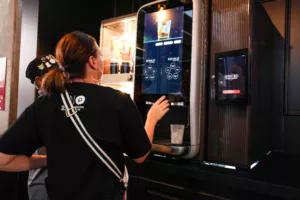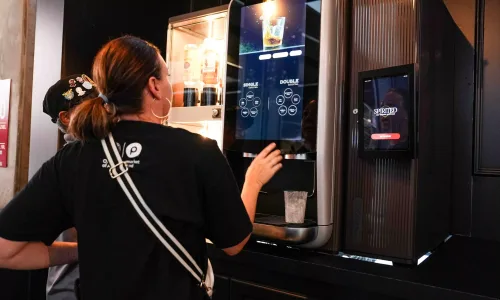KEY TAKEAWAYS
- Fans want more from stadiums, and sports orgs have spent billions on delivering it
- Stadiums, premium options, and technology for things like ticketing and concessions are improving as a result
- This is not only good for fans but for the bottom line of sports orgs
In the world of sports, a revolution is quietly unfolding. Gone are the days when a seat and a beer sufficed for the average sports fan. Today’s spectators, particularly the younger crowd, are demanding more—more engagement, personalization, and value for their hard-earned dollar. The question is: are sports organizations rising to meet these challenges? And what’s the smartest way to respond?
As we’ll explore in this article, the answers are “Yes” and “With investments that improve multiple areas at once.” Organizations have a vested interest in elevating the game-day experience, as it can supply a huge boost to their revenue per patron. Here, we’ll unpack how they’ve already responded to changing expectations, and why a vigorous response contributes to the health of their bottom line.
Why Listening to Fans Matters
Now more than ever, fans exert a unique influence on the transformation of sports teams and organizations. With social media at their disposal, they have the power to broadcast their preferences and critiques within the sports community on an unprecedented scale. This gives way to a de facto two-way communication channel between fans and teams. The organizations that embrace this new paradigm—viewing their fans as partners rather than just consumers—will likely emerge as winners in this new era of sports entertainment.
This evolution represents more than just a shift in business strategy; it’s a fundamental reimagining of the relationship between sports teams and their fans. By creating more interactive, personalized, and community-oriented experiences, sports organizations are not just selling tickets—they’re cultivating lifelong brand ambassadors.
Response #1: A Robust Financial Investment in Better Stadiums
Newer, shinier stadiums beget better fan experiences and are a huge factor in how sports organizations have risen to meet fan demands. Just consider the eye-popping amounts that they’ve shelled out on renovations in the last decade alone:
- Bank of America Stadium (Charlotte, NC):
- Approximately $250 million in upgrades over the past decade
- Lambeau Field (Green Bay, WI):
- The Green Bay Packers have spent roughly $500 million over the past 20 years
- Currently undergoing a sixth phase of renovations
- Hard Rock Stadium (Miami, FL):
- $600 million privately-funded renovation from 2015-2017
- Added a roof canopy, removed 10,000 upper deck seats, and created lavish club lounges
- Soldier Field (Chicago, IL):
- $660 million reconstruction completed in 2003
- Various college football stadiums:
- University of California-Berkeley’s Memorial Stadium: $321 million renovation
- University of Washington’s Husky Stadium: $250 million renovation
- University of Tennessee’s Neyland Stadium: $200 million renovation (ongoing)
- Rutgers University’s HighPoint Solutions Stadium: $102 million renovation
- Penn State University’s Beaver Stadium: $93 million renovation
There are myriad reasons why organizations have thrown billions of dollars at upgrades. For one, venues need to offer unique experiences to compete with improved home entertainment options. Some renovations are necessary to repair foundation problems or replace entire systems like plumbing or electrical. But perhaps most importantly, renovations can be in service of creating premium experiences for fans, which in turn become lucrative line items for the team and stadium.
Response #2: Honing in on the “Suite” Life
According to Colorado Biz, organizations have a keen eye on the luxury suite experience. For example, suites and premium seating partially drove a $100 million upgrade at Denver’s Empower Field. Coors Field and Dick’s Sporting Goods Park are likewise “reconfiguring older, stodgier suites into zippier, modernized spaces. They’re [also] rethinking the way they price, present, and market premium seats,” CB wrote.
The cost of 20-person suites can reach into the tens of thousands for regular games, generating far more revenue than the average ticket. However, it takes vigorous marketing efforts to fill them. This has led sports organizations to make efforts to democratize premium experiences, offering more budget-friendly options for fans in different tax brackets.
Whether it’s suites for as little as $2,500 or loge boxes that occupy the space between a normal arena ticket and a suite, options abound. Certain clubs and rooftops in this price range also lend themselves to more “party-like” atmospheres, which sports organizations are happy to cultivate on account of fans’ desire for them (and their willingness to pay for them).
Response #3: The Adoption of Newer Technology
Organizations have also consciously adapted how they interact with the everyday fan, particularly where digital technology is concerned. Digital transformation is unlocking unprecedented opportunities for growth in the sports industry, and it’s a ripe area for sports organizations to both identify and rise to fan expectations.
Some examples of sports orgs adopting new technology to appeal to fans include:
- Mobile Apps: Guide fans through stadiums, offering everything from wayfinding to seat upgrades, in-seat ordering, real-time stats, and instant replays
- Augmented Reality Experiences: Provide interactive elements during games
- Social Media Integration: Allows for real-time fan interaction and content sharing
- Facial Authentication: Allows for faster, more streamlined purchases at the stadium, as well as faster entry
Improving Concessions with Technology
Improving the concession experience has been and should remain a high priority for sports organizations. Concessions are described by Deloitte as “a favorite for fan complaints, and the source of some of the lowest satisfaction scores” in stadium experience surveys. Another source confirmed that “59% of fans said they would spend more at the concession stand if their wait time was reduced by 50%.” By investing in faster, more streamlined concessions with tech like facial purchasing, stadiums are directly addressing something that matters deeply to fans.
Why Investing in Fan Experiences Boosts Sports Organizations’ Bottom Line
When it comes to how sports organizations can financially benefit from the deliberate process of delivering (and selling) better fan experiences, Colorado Biz put it best:
“[They] have moved beyond a bygone economic formula: buy a team, and lose money for years while taking advantage of tax write-offs… The modern approach, instead, is to run prized sports assets with much more attention to the real-time P&L statement. The greater the profit, the more leeway to invest in players, coaches, facilities and resources.”
This deftly illustrates the connection between better fan experiences and a healthier bottom line for sports team owners and organizations.
Improved fan experiences directly impact various revenue channels, including:
- Ticket Sales: Engaged fans attend more games and are willing to pay premium prices for enhanced experiences
- Concessions and Merchandise: As mentioned, satisfied fans spend more on food, beverages, and team merchandise during events, especially when the checkout process is as seamless as showing their face
- Sponsorships: A large, engaged fanbase is highly attractive to potential sponsors, allowing teams to secure more lucrative sponsorship deals
- Subscriptions and Digital Content: Fans are more likely to purchase premium content, streaming services, or exclusive digital offerings
Giving the Fans What They Came to See
Sports organizations are responding to fans’ demands for “More!” through a multi-faceted approach that includes physical stadium improvements, diversification of seating options, and embracing digital technologies. These efforts aim to create more immersive, personalized, and engaging experiences for fans, while also opening up new revenue streams for the organizations themselves.
As we look to the future, one thing is clear: the game is changing, both on and off the field. The sports organizations that recognize this and adapt accordingly will not just survive—they’ll thrive, creating experiences that resonate with fans for generations to come. The ball is in their court!







